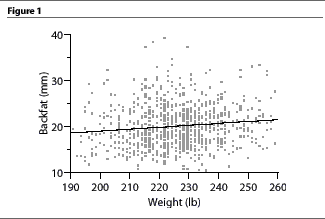 WHAT'S YOUR INTERPRETATION?
WHAT'S YOUR INTERPRETATION?
John Deen, University of Minnesota
 This graph shows the relationship between backfat and
weight for 900 pigs at slaughter. Should pigs be selected at lighter
weights to avoid penalties for excess backfat?
This graph shows the relationship between backfat and
weight for 900 pigs at slaughter. Should pigs be selected at lighter
weights to avoid penalties for excess backfat?
Sending pigs to slaughter at lighter weights is a very inaccurate and expensive way to control backfat levels.
Now for the rest of the story:
 As the classic "shotgun" pattern of the scattergraph
(Figure 1) shows, the individual pig can have a wide range in
its thickness of backfat at any weight. This means that although
the slope of this regression relationship differs significantly
from 0 (P=.0001), backfat is poorly predicted by weight.
The adjusted R2, which equals .016, is the more useful
statistical measure to predict backfat on the basis of bodyweight.
Crudely interpreted, an R2 of .016 means that only
1.6% of the variation in backfat is predicted by weight.
As the classic "shotgun" pattern of the scattergraph
(Figure 1) shows, the individual pig can have a wide range in
its thickness of backfat at any weight. This means that although
the slope of this regression relationship differs significantly
from 0 (P=.0001), backfat is poorly predicted by weight.
The adjusted R2, which equals .016, is the more useful
statistical measure to predict backfat on the basis of bodyweight.
Crudely interpreted, an R2 of .016 means that only
1.6% of the variation in backfat is predicted by weight.
This deviates from the common understanding that weight is a useful predictor of the amount of backfat. Where has this misconception come from? Most reports of the relationship between backfat and weight focus on changes in backfat on an individual-pig basis. For a specific pig, there is a very strong likelihood that backfat will increase with increased weight. The problem is that this relationship is overshadowed by the much larger variation in backfat among pigs.
However, this does not mean that reducing backfat should not be a management goal. To maximize profits, you should encourage your clients to control genetics, diet, and environment to reduce the overall effect of backfat on the amount received for market hogs.
